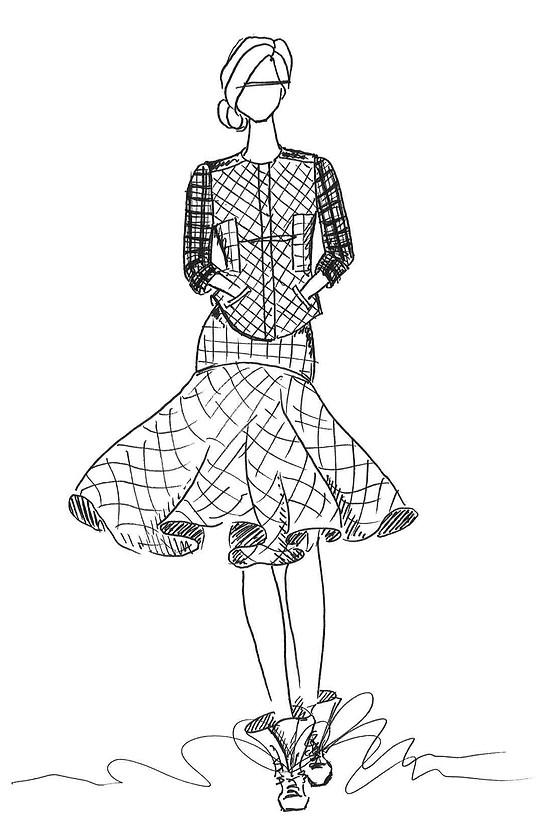Skillset
We will wear clothing for the entirety of our lives. Kate Fletcher proposes the idea of life skills as being a daily action that builds up to a lifelong journey (Fletcher & Tham, 2015). In this way, we not only curate wardrobes that last a lifetime, but we draw on our skill sets as wearers to maintain and service our lifelong wardrobe journey. Engaging in acts that uses ones hands and challenges creativity has also been identified as a human need that directly correlates with happiness and well-being (Holroyd, 2017). By using our own ideas and hands to alter our garments, both our clothing and our roles are transformed. We are no longer bystanders, but engaged users that are taking responsibility and control of our clothing. An individual does not need to make a garment from scratch to experience these benefits. Using skills like mending, altering, dyeing, hand sewing, basic repairs, and additions to garments are all ways to practice agency.
Production
Be a Part of Production: This is your clothing, be a part of it! Make it exactly what you want! Being able to create a garment and make every decision from beginning to end is empowering as a wearer. Every decision reflects your personal preferences, aesthetic, and personal values. Whether it's knitting, weaving, sewing, felting, pattern making, or draping, using your skills to show your style, make what you want, and express your personal values is a powerful expression of self.
How to apply this to your closet?
If you have the skills, USE THEM!
No matter if you are a beginner or have been making clothes for a lifetime, all skills are helpful and should be celebrated and USED when making your closet.

Obtaining
Value the Skills Used: No matter who made your clothes, yourself, a loved one, a friend, a community member, or a seamstress across the world, your garment should be valued not only because it is a resource but also because a human spent time and used their skills to make that garment.
How to apply this to your closet?
Be knitworthy! Knitworthy is someone who wears a knitting project no matter how it turns out, the garment is loved, worn, and used! Be the person that values the process and sees the value!
Support Artisans and Craftspeople: Anything made by hand is a celebration of human life and artistry. By purchasing goods that are made by hand with honed skillsets, and attention to detail, you are not only supporting the artisan but supporting a culture that values human accomplishment.
How to apply this to your closet?
Buy from artisans and craftspeople, locally and around the world!
Fair Trade: Fair Trade production systems are when every person within the production chain are paid a fair wage for their work and skill used to make an end product.
How to apply this to your closet?
Support Fair Trade by buying Fair Trade products!
Use/Reuse
Use Your Skills to Maintain Your Clothes: No matter your skill level, your skills should be celebrated and used! Go for it! Show off your crooked hem, your mismatched stitches, and your perfectly set armseye. Use YOUR skills. Whether it's mending, altering, updating, repurposing, dyeing, knitting, darning, or sewing a garment from scratch, using your skills gives you independence from the clothing industry. Instead of buying new jeans when they rip or buying all of your clothes from the garment industry, by making your own and mending what you already own you are able to meet your own needs without relying on an unsustainable system that might not mirror your personal values.
How to apply this to your closet?
Be PROUD of your skills and use them!
Learn out to mend, alter, darn, and patch and USE those skills.
Disposal
Repurpose Into New Goods: Your clothing can continue to be loved and used even after they can't be worn as clothing anymore. Repurposing your clothes into quilts, pillows, cushions, bags, scarfs, table linens, rags, or stuffing for pillows and cushions are just a few options! Use your skills to make something unique and special, while reducing the number of goods that end up in landfills.
How to apply this to your closet?
Be PROUD of your skills and use them!
Learn out to mend, alter, darn, and patch and USE those skills.
Donate to Groups that Encourage Skillsets: When donating clothes or materials you no longer want, think about donating to groups that need materials or that teach skillsets, like children's programs, or art programs in schools. This can range from places that teach sewing or knitting, or donating to quilting or weaving groups that will use your old clothes to make something new.
Want to make your donation meaningful?
Talk with local organizations, groups, or schools to build relationships to find the best way to upport them.


